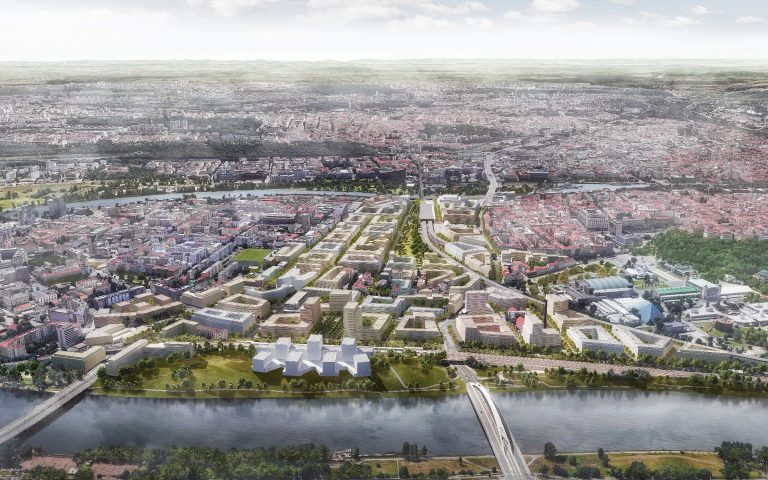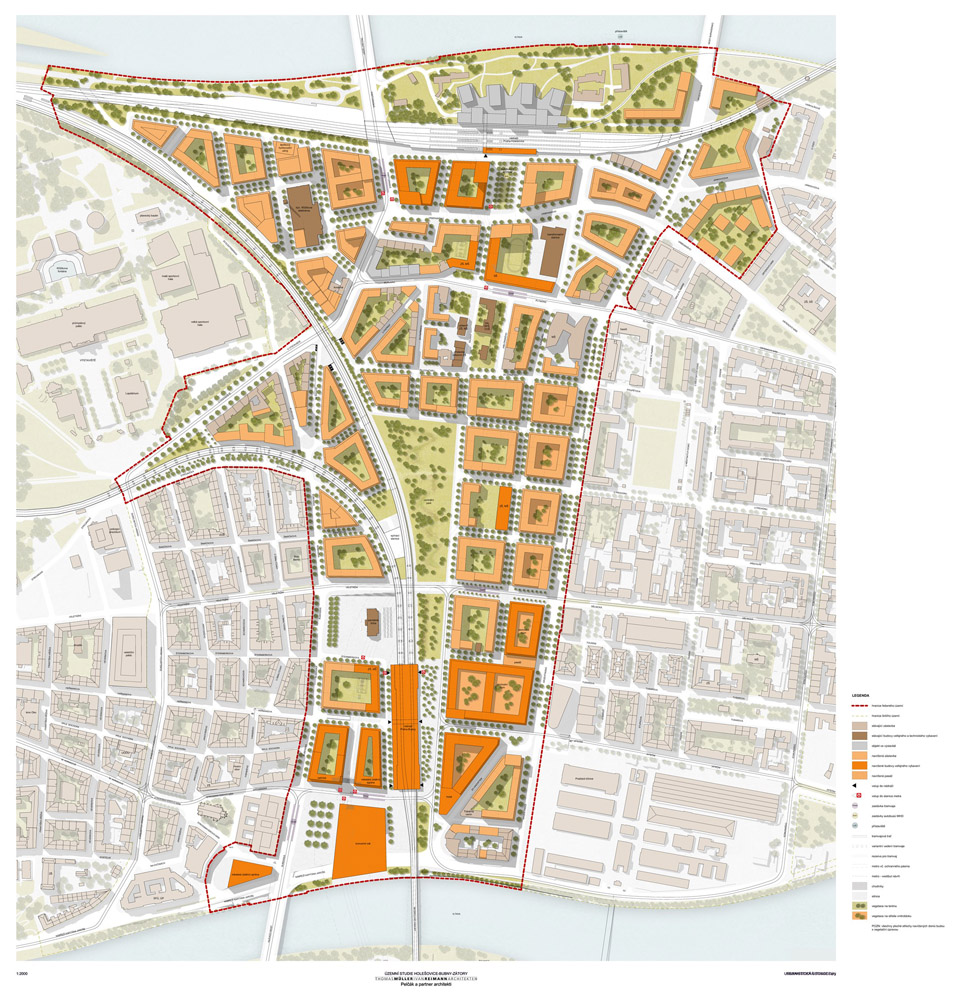After decades of discussion, Prague now has a realistic plan to turn a 110-hectare brownfield in Prague 7 into a full-fledged neighborhood. The complete design study, which will be published in July, shows a new look for the Bubny-Zátory area that could accommodate up to 25,000 inhabitants.
After public discussion and approval, the study will serve as a basis for changes to the land use plan. Construction could begin within five years, according to City Hall.
Starting in the 1980s, several plans were made to integrate the area into Prague but were never implemented. There was never any consensus on the plans, and Bubny-Zátory remained “the scar of Prague.”
In the last few years there has been movement to turn the brownfield into a full-fledged neighborhood where people can live and work. The city together with the Prague Institute of Planning and Development (IPR) decided in February 2018 to commission a territorial study to create a distinctive new neighborhood that will naturally build on its surroundings.
“In the assignment for the territorial study, the emphasis is mainly on the quality of life of Praguers. Therefore, there will be no lack of schools, kindergartens, culture, quality parks and comfortable streets in the new neighborhood. I am pleased that we are working hard to revive such an important part of the city,” First Deputy Mayor Petr Hlaváček (United Force for Prague) said on the City Hall website.
The new neighborhood should connect Letná and Holešovice, and provide a home for up to 25,000 inhabitants in 11,000 flats. That is about 230 inhabitants per hectare, which is close to the population density in Vinohrady. There will also be 5,000 spaces in schools.

The main residential area will be the southern half with a building height of approximately six to eight floors. This is similar to parts of Smíchov or Vinohrady at the beginning of the 20th century.
“We have a great opportunity to create a functional neighborhood that responds to the city’s current needs — especially the lack of housing. Housing should therefore be at least 60 percent [of the area],” Hlaváček said.
“First, a proposal will be created and discussed with the city district, the public and experts to remove any errors and inaccuracies, or to resolve the relationship between the owners and the city. I estimate that the final territorial study can be done near the end of the year,” he added.
The northern part will have a mix of administrative buildings and a residential area. The northern part will hold over 10,000 workers. According to the territorial study, the administrative buildings will have a basic height similar to the southern part.
At some points, tower levels can reach up to 18 to 21 floors. If a Government District is to be established in Prague, it would be appropriate for it to be established here: close to the city center, on the train, metro, tram and near the city ring road, the City Hall statement said, adding that it was more advantageous than a proposed site in Letňany.
The location is also suitable for the city administration.
A six-hectare central park of will be built in the center of the area. The park should be the heart of the territory and a new face of Holešovice. The park should be multifunctional and should offer Praguers various sports and recreational activities.

The park should also provide a green connection between the Vltava banks in the south, the new district, Výstaviště and Stromovka. Tree-lined streets, as well as the green roofs, are elements envisaged to address climate change.
“Bubny is the most important brownfield in the metropolis, and people from Prague 7 who are in charge of development have spent many hours working on this topic. A large and modern park will be a crucial meeting place, and we are pleased that the study envisages areas and activities for all generations,” Prague 7 Mayor Jan Čižinský (Praha sobě) said.
Bubny-Zátory is well connected by metro, trains, trams and in the future also by pedestrian and cycling routes. The city inner ring road also runs nearby. It will also be connected to the planned high-speed train to Václav Havel Airport. By the end of the summer, a detailed traffic model for the territorial study should be ready.
“In the first place are pedestrians, public transport and cycling. An important component of transport is also a suitable mix of housing, services and work. This means that if the residents in the new district cannot only live, but also shop, work and have fun, the number of trips around the city is reduced. This is how we imagine neighborhoods of the future — everything at hand,” Deputy Mayor Adam Scheinherr (Praha sobě) said. “However, we still have a lot of work to do to achieve the desired results,” he added.
New bridges and pedestrian bridges, a tram track and the revitalization of the Prague–Kladno railway line, which also includes the line to the airport, are also in the neighborhood plan. New connections and services should help lighten the load in the congested center.
Bubny’s dark history will also be remembered. Transport trains with tens of thousands of Jewish residents during World War II were dispatched from Bubny Station to ghettos and concentration camps. After World War II, Prague’s Germans of Prague departed from here.
“In the original train station building, now with the help of Prague, the Memorial of Silence is being created with a modern exhibition showing the complicated history of the 20th century and also a space for discussion and critical reflection on the recent past,” Prague 7 Deputy Mayor Lenka Burgerová said.
The appearance of the Memorial of Silence has recently been presented to the public and the monument itself should be realized in 2021.
A concert hall should also be created in the new neighborhood as part of a separate project.












 Reading time: 4 minutes
Reading time: 4 minutes 

























